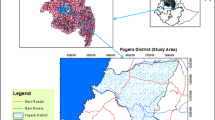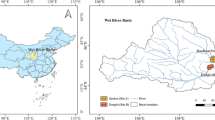Abstract
For efficient use of water as a limited resource, evaluation on the water value is critical, but there is little information in Asian paddy irrigation. This paper proposes the method for measuring implicit price of paddy irrigation water by using the choice experiment (CE) data with contingent scenarios. Empirical results demonstrated that (a) the estimated implicit price of water showed reasonable value as compared to the production indexes, (b) the random parameter multinomial logit model was more suitable than the conventional multinomial logit model to treat the CE data, and (c) the implicit price is much lower than the full cost price, indicating that full cost pricing probably damages and ruins rice production too seriously in Japan. As seen above, the method proposed here is useful for decision making on water pricing policies and easy to apply to different irrigation systems under limited data of water value.


Similar content being viewed by others
Notes
Estimations of the binomial logit model also show that no characteristic of individual farmers had effects as explanatory variables to separate opt-out case from others (Fitzgerald et al. 1998).
The price elasticity of water was calculated by (liner function) \( \eta_{\text{W}} = \frac{\partial W/W}{\partial R/R} = \frac{{\beta_{5} + \beta_{6} \bar{A}}}{{\beta_{1} }}\frac{{\bar{R}}}{{\bar{W}}} \), and (log-linear function) \( \eta_{\text{W}} = \frac{{\beta_{5} + \beta_{6} \ln (\bar{A})}}{{\beta_{1} }} \).
References
Bazzani GM, Pasquale DS, Gallerani V, Viaggi D (2004) Irrigated agriculture in Italy and water regulation under the European Union water framework directive. Water Resour Res 40(7):W07S04
Bennett J (2005) Australasian environmental economics: contributions, conflicts and ‘Cop-outs’. Aust J Agric Res Econ 49(3):243–261
Bennett J, Blamey R (2001) The choice modeling approach to environmental valuation. Edward Elger, UK
Brownstone D, Bunch D, Train K (2000) Joint mixed logit models of stated and revealed preferences for alternative-fuel vehicles. Transp Res Part B 34:315–338
Calatrava J, Garrido A (2005) Spot water market and risk in water supply. Agric Econ 33(2):131–143
Carson RT, Mitchell RC (1993) The value of clean water: the public’s willingness to pay for boatable, fishable, and swimmable quality water. Water Resour Res 29(7):2445–2454
Chakravorty U, Zilberman D (2000) Introduction to the special issue on: management of water resources for agriculture. Agric Econ 24(1):3–7
Conradie BI, Hoag DL (2004) A review of mathematical programming models of irrigation water values. Water SA 30(3):287–292
Fitzgerald J, Gottschalk P, Moffitt R (1998) An analysis of sample attrition in panel data: the Michigan panel study of income dynamics. J Human Resour 33(2):251–299
Fujimoto N, Tomosho T (2003) A viewpoint to apply water pricing to the Asian humid tropics. Paddy Water Environ 1:75–83
Gomez-Limon JA, Riesgo L (2004) Irrigation water pricing: differential impacts on irrigated farms. Water Resour Res 40(7):W07S05
Greene WH (2005) NLOGIT Version 3.0 reference guide. Econometric Software, Inc.
Hausman J, McFadden D (1984) Specification tests for the multinomial logit model. Econometrica 52:1219–1240
Hite D, Hudson D, Intarapapong W (2002) Willingness to pay for water quality improvements: the case of precision application technology. J Agric Resour Econ 27(2):433–449
Iglesias E, Garrido A, Gomez-Ramos A (2003) Evaluation of drought management in irrigated areas. Agric Econ 29(2):211–229
Jaeger WK (2004) Conflicts over water in the Upper Klamath Basin and the potential role for market-based allocation. J Agric Res Econ 29(2):167–184
Johansson RC (2000) Pricing irrigation water: a literature survey. World Bank, Washington, DC, pp 46–64
Kan I, Schwabe KA, Knapp KC (2002) Microeconomics of irrigation with saline water. J Agric Resour Econ 27(1):16–39
Kunimitsu Y (2006) Effects of socio-institutional and emotional factors on Japanese farmland rental transactions. J Agric Appl Econ 38(1):33–46
Matsuno Y, Hatcho N (2007) Water transfer from agriculture to urban domestic users: a case study of the Tone River Basin, Japan. Paddy Water Environ 5:239–246
Moore MR (1999) Estimating irrigators’ ability to pay for reclamation water. Land Econ 75(4):562–578
Nahuelhual L, Loureiro LM, Loomis J (2004) Using random parameters to account for heterogeneous preferences in contingent valuation of public open space. J Agric Resour Econ 29(3):537–552
OECD (1999) The price of water-trends in OECD countries. OECD, Paris, pp 69–70
Rogers P, Bhatia R, Huber A (1998) Water as a social and economic goods: how to put the principle into practice. Gliba Water Partnership Technical Advisory Group
Scheierling SM, Loomis IB, Young RA (2006) Irrigation water demand: a meta-analysis of price elasticities. Water Resour Res 42(11):W01411
Schoengold K, Sunding DL, Moreno G (2006) Price elasticity reconsidered: panel estimation of an agricultural water demand function. Water Resour Res 42(9):W09411
Train K (2003) Discrete choice methods with simulation. Cambridge University Press, Cambridge
Varela-Ortega C, Sumpsi JM, Garrido A, Blanco M, Iglesias E (1998) Water pricing policies, public decision making and farmers’ response: implications for water policy. Agric Econ 19(1–2):193–202
Wang H, Lall S (2002) Valuing water for Chinese industries: a marginal productivity analysis. Appl Econ 34:759–765
Weinberg M (2002) Assessing a policy grab bag: federal water policy reform. Am J Agric Econ 84(3):541–556
Acknowledgments
The author obtained many useful comments on an earlier draft of the paper at the 5th International Conference of Asian Society of Agricultural Economics and Agricultural Engineering World Congress 2006. Also this paper was checked by Dr. DeMar Taylor (University of Tsukuba) and International Science Editing Co. Ltd. These comments and contributions are gratefully acknowledged. The author is responsible for any errors.
Author information
Authors and Affiliations
Corresponding author
Rights and permissions
About this article
Cite this article
Kunimitsu, Y. Measuring the implicit value of paddy irrigation water: application of RPML model to the contingent choice experiment data in Japan. Paddy Water Environ 7, 177–185 (2009). https://doi.org/10.1007/s10333-009-0159-9
Received:
Revised:
Accepted:
Published:
Issue Date:
DOI: https://doi.org/10.1007/s10333-009-0159-9




